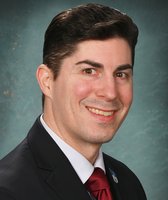Stand up for the facts!
Our only agenda is to publish the truth so you can be an informed participant in democracy.
We need your help.
I would like to contribute

Kristina Karamo, Republican candidate for Michigan secretary of state, shakes hands with former President Donald Trump during a Save America rally at the Michigan Stars Sports Center in Washington Township on April 2, 2022.
If Your Time is short
-
Michigan secretary of state candidate Kristina Karamo leveled allegations of wrongdoing after the 2020 presidential election, claiming she witnessed misconduct while working as an election challenger in Detroit.
-
Election officials say that her claims mistook standard processes for something nefarious.
Republican Kristina Karamo launched her campaign for Michigan secretary of state with a passionate campaign promise.
"I am running to remove corruption from our elections and from the Michigan SOS office," she said in a statement announcing her bid.
This vow to clean up elections stemmed from her experience in 2020 as a presidential election challenger in Detroit. Following the election, she appeared on conservative television programs, testified before state lawmakers and participated in legal efforts to fight the election results, claiming that she witnessed misconduct as she observed election workers processing and counting ballots at the Detroit convention hall formerly known as the TCF Center.
But a close look at her allegations about the last election show they don’t provide evidence of fraud or wrongdoing. Rather, PolitiFact Michigan found, Karamo appears to mistake standard processes for something nefarious.
Karamo’s election-denying claims seem to have resounded with former President Donald Trump and the Michigan GOP, who have both endorsed her.
She did not respond to PolitiFact Michigan’s request for comment. Here’s a closer look at the factual accuracy of Karamo’s statements that she suggested show evidence of a fraudulent election.
A week after the 2020 election, Karamo signed an "incident report" detailing what she said she saw at the convention center in Detroit where she worked as an election challenger. The report was filed in support of a lawsuit that sought to delay the certification of the results. It was dismissed along with similar challenges.
In her report, Karamo said she was stationed at the adjudication table where election workers reviewed ballots rejected by the electronic voting tabulators. She said that one ballot showed a voter had filled in two complete circles: one straight party vote for the Democratic Party and the other a straight party vote for the Republican Party.
Karamo said that one of the election workers "decided to give it to the Democrats" when the ballot should have been tossed out. Karamo said that a supervisor instructed the election worker to count the ballot, telling her to "push it through," refusing to let Karamo challenge it.
Chris Thomas, Michigan’s former director of elections who was working at the Detroit counting room, cast doubt on Karamo’s account.
He said there should be no controversy about how to count a ballot with two clear markings for a straight party vote for both parties. Election officials call that an "overvote," because the voter voted for more than the number of candidates allowed, nullifying the vote. Michigan election officials are required to program tabulators to reject ballots containing overvotes.
"It makes no sense whatsoever. If there’s anything more basic about an overvote, I don’t know what it is," Thomas said. "There’s not a lot of room here for people to be parceling votes one way or the other."
A ballot sent to the adjudication table would have already been considered an overvote and an election worker would have had to change the markings in order to alter how the machine read it, Thomas said. But Karamo’s incident report doesn’t mention any alterations made to the ballot such as the election inspector erasing the straight party Republican vote. "There’s nothing in here in her discussion of seeing it actually changed on the screen," Thomas said.
Thomas said that election workers don’t alter ballots unless a marking indicates that the voter clearly intended to vote one way, such as a completely filled-in circle for one candidate and a stray pen dot inside the circle for another.
"Almost everything they look at that comes to them, they’re going to push it through as it is," he said. Thomas questioned Karamo’s interpretation that the "push it through" instruction was actually a command to count the ballot for Biden. Thomas said it likely meant to "just push it through as an overvote, nobody gets the vote," he said.
In the wake of the 2020 election, social media was flooded with misleading reports claiming ballots that arrived overnight were a sign of election fraud. Those reports misunderstood how absentee ballots are processed and tabulated.
Karamo said in her incident report that she witnessed "ballots being delivered" between 3 and 3:30 a.m. on Wednesday, Nov. 4, the day after Election Day.
In Michigan, voters had until 8 p.m. on Election Day to return absentee ballots. That was the deadline for casting ballots, not delivering or counting them.
In a sworn affidavit that Thomas wrote that no absentee ballots returned after the 8 p.m. Election Day deadline were ever counted.
However, Thomas’ affidavit explained, approximately 16,000 ballots in 45 trays containing approximately 350 ballots each were delivered early in the morning on Wednesday in a white van used by the city. All those ballots were verified as belonging to eligible voters who returned them on time before they arrived at the counting room, Thomas said.
This was another claim Karamo included in her November 2020 incident report filed in support of a lawsuit to delay the vote certification.
The election workers in Detroit who counted absentee ballots were working from a poll book that was downloaded before Election Day. They were also given a supplemental list of voters who returned ballots after the poll book was downloaded but before the 8 p.m. Election Day deadline for casting ballots.
Thomas said that during the vote count, it was discovered that some ballots were not attached to voters’ names in either the poll book or the supplemental list. That was because the election workers did not complete the final step of processing receipt of the ballots before sending them to the counting center.
But the affected ballots had timestamps indicating that they were returned before the deadline, Thomas said.
The names and addresses of the affected voters had to be keyed into the poll book, Thomas said. The poll book also requires entering voters’ birth dates, which Detroit election workers did not have on hand without access to Michigan’s complete voter file.
So election workers used a placeholder birth date of 1/1/1900. Placeholder dates are commonly used by election offices when they lack records to show the actual birth date for voters. "It doesn’t mean the voter doesn’t have a birth date on their record. It just means that the people that were putting them in the poll book had no access to that file," Thomas said.
More recently on the campaign trail, Karamo said state records indicated that she didn’t vote in the 2020 presidential election.
"You know what’s interesting, is according to the State of Michigan, I didn’t vote in the 2020 election," she said, speaking at a rally alongside Trump in Macomb County in April. "And what’s so interesting, of all the lies told about me, that’s the most infuriating thing. Like why would I spend all that time at the TCF Center, knock doors for President Trump and turn around and not vote?"
She said that she submitted a records request for her application to vote, "proving that I voted in the 2020 election even though according to the state of Michigan I didn’t vote."
At one point, the state’s voter file did indicate that Karamo did not vote in the 2020 election, but that was due to a clerical error, according to her local election administrator, Oak Park City Clerk Ed Norris, and has since been corrected.
Norris confirmed that Karamo voted in the 2020 general election. He said that in response to Karamo’s records request, his office provided her application to vote, which she signed before voting in person at her polling location.
Norris said that Karamo was among 700 voters whose voting activity was not initially uploaded to the voter file. The initial upload error did not impact how those voters’ ballots were counted, Norris said.
Tracy Wimmer, a spokesperson for the Michigan Department of State, confirmed that the qualified voter file was updated recently and indicates that Karamo voted in person in 2020.
Our Sources
Chris Thomas, affidavit, Costantino et al v. Detroit et al, Nov. 11, 2020
Judge Timothy Kenny, opinion and order, Costantino et al v. Detroit et al, Nov. 13, 2020
Chris Thomas, former Michigan elections director, phone interview, April 18, 2022
Tracy Wimmer, Michigan Department of State spokesperson, email, April 4, 2022
Kristina Karamo, remarks at Macomb County Trump rally, April 2, 2022
Kristina Karamo, incident report, signed Nov. 10, 2020
Kristina Karamo, testimony to Michigan Senate Oversight Committee, Dec. 1, 2020
Ed Norris, Oak Park clerk, phone interview, April 5, 2022
Ed Norris, Oak Park clerk, email, April 5, 2022
Michigan Election Officials’ Manual, Michigan Bureau of Elections, Chapter 10: Preparation of Election Equipment, updated February 2019
MLive, "Republican who challenged Michigan election results now running for Secretary of State," May 13, 2021
PolitiFact, "Election workers didn’t ‘find’ Biden votes overnight. They counted and reported mail in ballots," Nov. 10, 2020
The Detroit Free Press, "Michigan Supreme Court, in 4-3 decision, refuses to hear election fraud case," Dec. 9, 2020












































